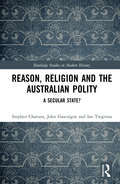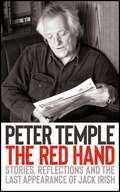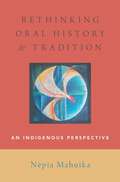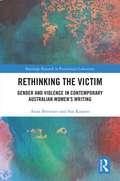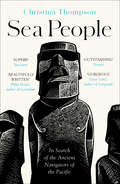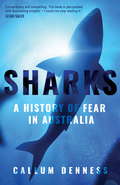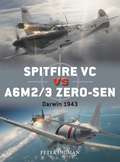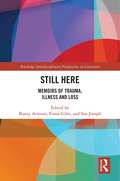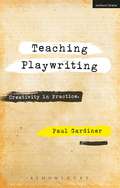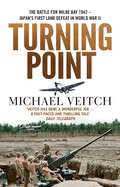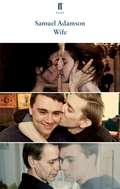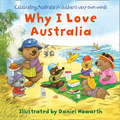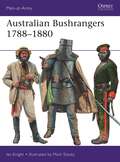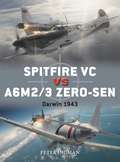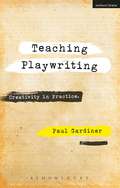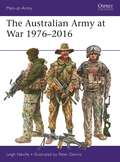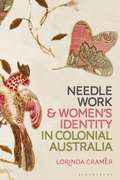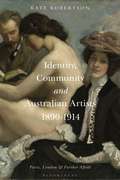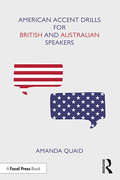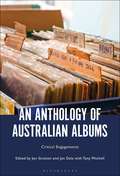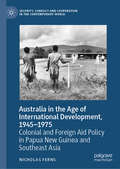- Table View
- List View
Reason, Religion and the Australian Polity: A Secular State? (Routledge Studies in Modern History)
by Stephen A. Chavura John Gascoigne Ian TregenzaHow did the concept of the secular state emerge and evolve in Australia and how has it impacted on its institutions? This is the most comprehensive study to date on the relationship between religion and the state in Australian history, focusing on the meaning of political secularity in a society that was from the beginning marked by a high degree of religious plurality. This book tracks the rise and fall of the established Church of England, the transition to plural establishments, the struggle for a public Christian-secular education system, and the eventual separation of church and state throughout the colonies. The study is unique in that it does not restrict its concern with religion to the churches but also examines how religious concepts and ideals infused apparently secular political and social thought and movements making the case that much Australian thought and institution building has had a sacral-secular quality. Social welfare reform, nationalism, and emerging conceptions of citizenship and civilization were heavily influenced by religious ideals, rendering problematic traditional linear narratives of secularisation as the decline of religion. Finally the book considers present day pluralist Australia and new understandings of state secularity in light of massive social changes over recent generations.
The Red Hand: Stories, reflections and the last appearance of Jack Irish
by Peter TemplePeter Temple held crime writing up to the light and, with his poet's ear and eye, made it his own incomparable thing.Peter Temple started publishing novels late, when he was fifty, but then he got cracking. He wrote nine novels in thirteen years. Along the way he wrote screenplays, stories, dozens of reviews.When Temple died in March 2018 there was an unfinished Jack Irish novel in his drawer. It is included in The Red Hand, and it reveals the master at the peak of his powers. The Red Hand also includes the screenplay of Valentine's Day, an improbably delightful story about an ailing country football club, which in 2007 was adapted for television by the ABC. Also included are his short fiction, his reflections on the Australian idiom, a handful of autobiographical fragments, and a selection of his brilliant book reviews. .
Rethinking Oral History and Tradition: An Indigenous Perspective (Oxford Oral History Series)
by Nepia MahuikaIndigenous peoples have our own ways of defining oral history. For many, oral sources are shaped and disseminated in multiple forms that are more culturally textured than just standard interview recordings. For others, indigenous oral histories are not merely fanciful or puerile myths or traditions, but are viable and valid historical accounts that are crucial to native identities and the relationships between individual and collective narratives. This book challenges popular definitions of oral history that have displaced and confined indigenous oral accounts as merely oral tradition. It stands alongside other marginalized community voices that highlight the importance of feminist, Black, and gay oral history perspectives, and is the first text dedicated to a specific indigenous articulation of the field. Drawing on a Maori indigenous case study set in Aotearoa New Zealand, this book advocates a rethinking of the discipline, encouraging a broader conception of the way we do oral history, how we might define its form, and how its politics might move beyond a subsuming democratization to include nuanced decolonial possibilities.
Rethinking the Victim: Gender and Violence in Contemporary Australian Women's Writing (Routledge Research in Postcolonial Literatures)
by Anne Brewster Sue KossewThis book is the first to examine gender and violence in Australian literature. It argues that literary texts by Australian women writers offer unique ways of understanding the social problem of gendered violence, bringing this often private and suppressed issue into the public sphere. It draws on the international field of violence studies to investigate how Australian women writers challenge the victim paradigm and figure women’s agencies. In doing so, it provides a theoretical context for the increasing number of contemporary literary works by Australian women writers that directly address gendered violence, an issue that has taken on urgent social and political currency. By analysing Australian women’s literary representations of gendered violence, this book rethinks victimhood and agency, particularly from a feminist perspective. One of its major innovations is that it examines mainstream Australian women’s writing alongside that of Indigenous and minoritised women. In doing so it provides insights into the interconnectedness of Australia’s diverse settler, Indigenous and diasporic histories in chapters that examine intimate partner violence, violence against Indigenous women and girls, family violence and violence against children, and the war and political violence.
Rethinking the Victim: Gender and Violence in Contemporary Australian Women's Writing (Routledge Research in Postcolonial Literatures)
by Anne Brewster Sue KossewThis book is the first to examine gender and violence in Australian literature. It argues that literary texts by Australian women writers offer unique ways of understanding the social problem of gendered violence, bringing this often private and suppressed issue into the public sphere. It draws on the international field of violence studies to investigate how Australian women writers challenge the victim paradigm and figure women’s agencies. In doing so, it provides a theoretical context for the increasing number of contemporary literary works by Australian women writers that directly address gendered violence, an issue that has taken on urgent social and political currency. By analysing Australian women’s literary representations of gendered violence, this book rethinks victimhood and agency, particularly from a feminist perspective. One of its major innovations is that it examines mainstream Australian women’s writing alongside that of Indigenous and minoritised women. In doing so it provides insights into the interconnectedness of Australia’s diverse settler, Indigenous and diasporic histories in chapters that examine intimate partner violence, violence against Indigenous women and girls, family violence and violence against children, and the war and political violence.
Sea People: In Search Of The Ancient Navigators Of The Pacific
by Christina Thompson‘Wonderfully researched and beautifully written’ Philip Hoare, author of Leviathan ‘Succeeds in conjuring a lost world’ Dava Sobel, author of Longitude ‘Fascinating and satisfying’ Simon Winchester, author of The Map that Changed the World
Sharks: A History Of Fear In Australia
by Callum DennessFor as long as people have lived in Australia, the shark has loomed large in our fears. From the Noongar people of Western Australia who stayed out of the water for fear of being taken, to media hysteria about attacks and even sightings today, sharks occupy the dark recesses of our national psyche unlike any other predator. They challenge the very sense of ourselves as Australians, a people who hug the coastline and love the freedom of the surf. And the dispute between whether to kill or protect sharks cuts to the political core of our nation, yet another divide between the right and the left. There is no denying that shark attacks have been increasing in recent years, and so have our fears. Where do we go from here? How worried should we be? Journalist Callum Denness deep-dives into the history of our relationship with sharks, and circles our fear by talking to activists, marine biologists, politicians, surfers, survivors and those who’ve lost loved ones. Compelling and challenging, this is the clearest picture yet of whether or not we can co-exist with sharks. Don’t get back into the water until you read Sharks: A History of Fear in Australia.
Spitfire VC vs A6M2/3 Zero-sen: Darwin 1943 (Duel)
by Peter IngmanJust weeks after Pearl Harbor, Darwin was mauled by a massive Japanese attack. Without a single fighter to defend Australian soil, the Australian government made a special appeal to Britain for Spitfires. A year later the Spitfire VC-equipped No 1 Fighter Wing, RAAF, faced the battle-hardened 202nd Kokutai of the IJNAF, equipped with A6M2 Zero-sens, over Darwin. This was a gruelling campaign between evenly matched foes, fought in isolation from the main South Pacific battlegrounds. Pilots on either side had significant combat experience, including a number of Battle of Britain veterans. The Spitfire had superior flight characteristics but was hampered by short range and material defects in the tropical conditions, while the Japanese employed better tactics and combat doctrine inflicting serious losses on the over-confident Commonwealth forces. Fully illustrated with detailed full-colour artwork, this is the gripping story of two iconic aircraft facing off against each other above Australia.
Still Here: Memoirs of Trauma, Illness and Loss (Routledge Interdisciplinary Perspectives on Literature)
by Bunty Avieson Fiona Giles Sue JosephStill Here: Memoirs of Trauma, Illness and Loss explores the history, ethics, and cross-cultural range of memoirs focusing on illness, death, loss, displacement, and other experiences of trauma. From Walt Whitman’s Civil War diaries to kitchen table survivor-to-survivor storytelling following Hurricane Katrina, from social media posts from a refugee detention centre, to poetry by exiles fleeing war zones, the collection investigates trauma memoir writing as healing, as documentation of suffering and disability, and as political activism. Editors Bunty Avieson, Fiona Giles and Sue Joseph have brought together this scholarly collection as a sequel to their earlier Mediating Memory (Routledge 2018), providing a closer look at the specific concerns of trauma memoir, including conflict and intergenerational trauma; the therapeutic potential and risks of trauma life writing; its ethical challenges; and trauma memoir giving voice to minority experiences.
Still Here: Memoirs of Trauma, Illness and Loss (Routledge Interdisciplinary Perspectives on Literature)
by Bunty Avieson Fiona Giles Sue JosephStill Here: Memoirs of Trauma, Illness and Loss explores the history, ethics, and cross-cultural range of memoirs focusing on illness, death, loss, displacement, and other experiences of trauma. From Walt Whitman’s Civil War diaries to kitchen table survivor-to-survivor storytelling following Hurricane Katrina, from social media posts from a refugee detention centre, to poetry by exiles fleeing war zones, the collection investigates trauma memoir writing as healing, as documentation of suffering and disability, and as political activism. Editors Bunty Avieson, Fiona Giles and Sue Joseph have brought together this scholarly collection as a sequel to their earlier Mediating Memory (Routledge 2018), providing a closer look at the specific concerns of trauma memoir, including conflict and intergenerational trauma; the therapeutic potential and risks of trauma life writing; its ethical challenges; and trauma memoir giving voice to minority experiences.
Teaching Playwriting: Creativity in Practice
by Paul GardinerPlaywriting is a skill under-explored in the classroom, despite the strong evidence that it's an engaging and rewarding activity for young people. Teaching Playwriting addresses this gap and is an essential resource for teachers wanting to gain the skills and confidence necessary to introduce playwriting to their students. Based on rich research and clearly explained theoretical concepts, the book explores the lessons from creativity theory that will provide the teacher with the skills and knowledge necessary to empower students' writing and creativity. It also includes extensive practical activities and writing exercises to develop students' playwriting proficiency and creative capacity.Discussing key concepts in playwriting such as idea, dialogue, character, action and structure, the book enables teachers to respond to the unique learning needs of their students and help them tell their stories and reach their potential as young playwrights.
Turning Point: The Battle for Milne Bay 1942 - Japan's first land defeat in World War II
by Michael VeitchSeptember 1942 marked the high-point of Axis conquest in World War II. In the Pacific, Japan's soldiers had seemed unstoppable. However, the tide was about to turn.On Sunday, 6 September 1942, Japanese land forces suffered their first conclusive defeat at the hands of the Allies. At Milne Bay in Papua New Guinea, a predominantly Australian force - including 75 Squadron (fresh from their action in 44 Days) - fought for two weeks to successfully defend a vital airstrip against a determined Japanese invasion. The victorious Australian army units were crucially supported by two locally-based squadrons of RAAF Kittyhawks.The Battle for Milne Bay and victory for the Allies was a significant turning point in the Pacific War, but while it received worldwide publicity at the time, it has since been largely forgotten... It deserves to be remembered. Michael Veitch, actor, presenter and critically acclaimed author, brings to life the incredible exploits and tragic sacrifices of these Australian heroes in another fast-paced and thrilling tale.
Wife
by Samuel Adamson- And your husband forgave you. But what did you do? Decided that forgiveness was offensive and walked out on your marriage. With nothing. Into nothing.- Into everything, I think.It's 1959. Robert leaves Ibsen's A Doll's House outraged by its attack on the sanctity of marriage; his wife Daisy dashes round to the stage door, in love with both Nora and the actress who plays her, thrilled by their promise of escape.Daisy is at the crossroads. Her moral compass tells her to go one way, society the other. What she chooses to do next will have consequences not just for her and Robert, but for four couples who come after them over ninety years.The truth is we have to give up parts of ourselves if we want to be with someone. And what if, before you know this, you run away from the wrong person?Samuel Adamson's Wife premiered at the Kiln Theatre, London, in May 2019.
Why I Love Australia
by Daniel HowarthFeaturing children’s own words and heart-warming pictures, this board book, this is the perfect book for children living in, or visiting Australia.
Australian Bushrangers 1788–1880 (Men-at-Arms)
by Ian KnightThe first 'bushrangers' or frontier outlaws were escaped or time-expired convicts, who took to the wilderness – 'the bush' – in New South Wales and on the island of Tasmania. Initially, the only Crown forces available were redcoats from the small, scattered garrisons, but by 1825 the problem of outlawry led to the formation of the first Mounted Police from these soldiers. The gold strikes of the 1860s attracted a new group of men who preferred to get rich by the gun rather than the shovel. The roads, and later railways, that linked the mines with the cities offered many tempting targets and were preyed upon by the bushrangers. This 1860s generation boasted many famous outlaws who passed into legend for their boldness. The last outbreak came in Victoria in 1880, when the notorious Kelly Gang staged several hold-ups and deliberately ambushed the pursuing police. Their last stand at Glenrowan has become a legendary episode in Australian history. Fully illustrated with some rare period photographs, this is the fascinating story of Australia's most infamous outlaws and the men tasked with tracking them down.
Spitfire VC vs A6M2/3 Zero-sen: Darwin 1943 (Duel)
by Peter IngmanJust weeks after Pearl Harbor, Darwin was mauled by a massive Japanese attack. Without a single fighter to defend Australian soil, the Australian government made a special appeal to Britain for Spitfires. A year later the Spitfire VC-equipped No 1 Fighter Wing, RAAF, faced the battle-hardened 202nd Kokutai of the IJNAF, equipped with A6M2 Zero-sens, over Darwin. This was a gruelling campaign between evenly matched foes, fought in isolation from the main South Pacific battlegrounds. Pilots on either side had significant combat experience, including a number of Battle of Britain veterans. The Spitfire had superior flight characteristics but was hampered by short range and material defects in the tropical conditions, while the Japanese employed better tactics and combat doctrine inflicting serious losses on the over-confident Commonwealth forces. Fully illustrated with detailed full-colour artwork, this is the gripping story of two iconic aircraft facing off against each other above Australia.
Teaching Playwriting: Creativity in Practice
by Paul GardinerPlaywriting is a skill under-explored in the classroom, despite the strong evidence that it's an engaging and rewarding activity for young people. Teaching Playwriting addresses this gap and is an essential resource for teachers wanting to gain the skills and confidence necessary to introduce playwriting to their students. Based on rich research and clearly explained theoretical concepts, the book explores the lessons from creativity theory that will provide the teacher with the skills and knowledge necessary to empower students' writing and creativity. It also includes extensive practical activities and writing exercises to develop students' playwriting proficiency and creative capacity.Discussing key concepts in playwriting such as idea, dialogue, character, action and structure, the book enables teachers to respond to the unique learning needs of their students and help them tell their stories and reach their potential as young playwrights.
The Australian Army at War 1976–2016 (Men-at-Arms)
by Leigh NevilleSince the end of their involvement in the Vietnam War, the Australian Army has been modernized in every respect. After peacekeeping duties in South-East Asia, Africa and the Middle East in the 1980s–90s, 'Diggers' were sent to safeguard the newly independent East Timor from Indonesian harassment in 1999, and to provide long-term protection and mentoring since 2006. Australian Army units have served in the US-led wars in Iraq and Afghanistan, and Australian Special Forces are currently operating alongside US and British elements against ISIS in northern Iraq. During these campaigns the Australian SAS Regiment and Commandos have fully matured into 'Tier 1' assets, internationally recognized for their wide range of capabilities. The book, written by an Australian author who has written extensively about modern warfare, traces the development of the Army's organization, combat uniforms, load-bearing equipment, small arms and major weapon systems using specially commissioned artwork and photographs.
Needlework and Women’s Identity in Colonial Australia
by Lorinda CramerIn gold-rush Australia, social identity was in flux: gold promised access to fashionable new clothes, a grand home, and the goods to furnish it, but could not buy gentility. Needlework and Women's Identity in Colonial Australia explores how the wives, mothers, sisters, and daughters who migrated to the newly formed colony of Victoria used their needle skills as a powerful claim to social standing.Focusing on one of women's most common daily tasks, the book examines how needlework's practice and products were vital in the contest for social position in the turmoil of the first two decades of the Victorian rush from 1851. Placing women firmly at the center of colonial history, it explores how the needle became a tool for stitching together identity. From decorative needlework to household making and mending, women's sewing was a vehicle for establishing, asserting, and maintaining social status.Interdisciplinary in scope, Needlework and Women's Identity in Colonial Australia draws on material culture, written primary sources, and pictorial evidence, to create a rich portrait of the objects and manners that defined genteel goldfields living. Giving voice to women's experiences and positioning them as key players in the fabric of gold-rush society, this volume offers a fresh critical perspective on gender and textile history.
Identity, Community & Australian Artists, 1890-1914: Paris, London and Further Afield
by Kate R. RobertsonAn irresistible call lured Australian artists abroad between 1890 and 1914, a transitional period immediately pre- and post-federation. Travelling enabled an extension of artistic frontiers, and Paris – the centre of art – and London – the heart of the Empire – promised wondrous opportunities. These expatriate artists formed communities based on their common bond to Australia, enacting their Australian-ness in private and public settings. Yet, they also interacted with the broader creative community, fashioning a network of social and professional relationships. They joined ateliers in Paris such as the Académie Julian, clubs like the Chelsea Arts Club in London and visited artist colonies including St Ives in England and Étaples in France. Australian artists persistently sought a sense of belonging, negotiating their identity through activities such as plays, balls, tableaux, parties, dressing-up and, of course, the creation of art. While individual biographies are integral to this study, it is through exploring the connections between them that it offers new insights. Through utilising extensive archival material, much of which has limited or no publication history, this book fills a gap in existing scholarship. It offers a vital exploration re-consideration of the fluidity of identity, place and belonging in the lives and work of Australian artists in this juncture in British-Australian history.
Rethinking Oral History and Tradition: An Indigenous Perspective (Oxford Oral History Series)
by Nepia MahuikaIndigenous peoples have our own ways of defining oral history. For many, oral sources are shaped and disseminated in multiple forms that are more culturally textured than just standard interview recordings. For others, indigenous oral histories are not merely fanciful or puerile myths or traditions, but are viable and valid historical accounts that are crucial to native identities and the relationships between individual and collective narratives. This book challenges popular definitions of oral history that have displaced and confined indigenous oral accounts as merely oral tradition. It stands alongside other marginalized community voices that highlight the importance of feminist, Black, and gay oral history perspectives, and is the first text dedicated to a specific indigenous articulation of the field. Drawing on a Maori indigenous case study set in Aotearoa New Zealand, this book advocates a rethinking of the discipline, encouraging a broader conception of the way we do oral history, how we might define its form, and how its politics might move beyond a subsuming democratization to include nuanced decolonial possibilities.
American Accent Drills for British and Australian Speakers
by Amanda QuaidAmerican Accent Drills for British and Australian Speakers provides a comprehensive guide to learning a "General American" accent, made specifically for native English speakers. Unlike most American accent guides, which are geared toward ESL learners, this handbook covers only the shifts that English speakers need to make – nothing more, nothing less. In addition to vowel and consonant drills, it covers the finer points of American intonation and elision, features that often elude English speakers of other dialects. Finally, it provides exercises for "owning" the dialect, finding authenticity and making it work for each individual actor in their own way. This is an excellent resource for students of speech and dialects, actors from the UK, Australia, and New Zealand, and advanced ESL learners who need to use an American accent on screen or on stage. American Accent Drills for British and Australian Speakers also includes access to downloadable audio files of the practice drills featured in the book, to help students practice and perfect their American accent.
American Accent Drills for British and Australian Speakers
by Amanda QuaidAmerican Accent Drills for British and Australian Speakers provides a comprehensive guide to learning a "General American" accent, made specifically for native English speakers. Unlike most American accent guides, which are geared toward ESL learners, this handbook covers only the shifts that English speakers need to make – nothing more, nothing less. In addition to vowel and consonant drills, it covers the finer points of American intonation and elision, features that often elude English speakers of other dialects. Finally, it provides exercises for "owning" the dialect, finding authenticity and making it work for each individual actor in their own way. This is an excellent resource for students of speech and dialects, actors from the UK, Australia, and New Zealand, and advanced ESL learners who need to use an American accent on screen or on stage. American Accent Drills for British and Australian Speakers also includes access to downloadable audio files of the practice drills featured in the book, to help students practice and perfect their American accent.
An Anthology of Australian Albums: Critical Engagements
by Tony Mitchell Jon Stratton Jon DaleAn Anthology of Australian Albums offers an overview of Australian popular music through the lens of significant, yet sometimes overlooked, Australian albums. Chapters explore the unique qualities of each album within a broader history of Australian popular music. Artists covered range from the older and non-mainstream yet influential, such as the Missing Links, Wendy Saddington and the Coloured Balls, to those who have achieved very recent success (Courtney Barnett, Dami Im and Flume) and whose work contributes to international pop music (Sia), to the more exploratory or experimental (Curse ov Dialect and A.B. Original). Collectively the albums and artists covered contribute to a view of Australian popular music through the non-canonical, emphasizing albums by women, non-white artists and Indigenous artists, and expanding the focus to include genres outside of rock including hip hop, black metal and country.
Australia in the Age of International Development, 1945–1975: Colonial and Foreign Aid Policy in Papua New Guinea and Southeast Asia (Security, Conflict and Cooperation in the Contemporary World)
by Nicholas FernsThis book examines Australian colonial and foreign aid policy towards Papua New Guinea and Southeast Asia in the age of international development (1945–1975). During this period, the academic and political understandings of development consolidated and informed Australian attempts to provide economic assistance to the poorer regions to its north. Development was central to the Australian colonial administration of PNG, as well as its Colombo Plan aid in Asia. In addition to examining Australia’s perception of international development, this book also demonstrates how these debates and policies informed Australia’s understanding of its own development. This manifested itself most clearly in Australia’s behavior at the 1964 United Nations Conference on Trade and Development (UNCTAD). The book concludes with a discussion of development and Australian foreign aid in the decade leading up to Papua New Guinea’s independence, achieved in 1975.
